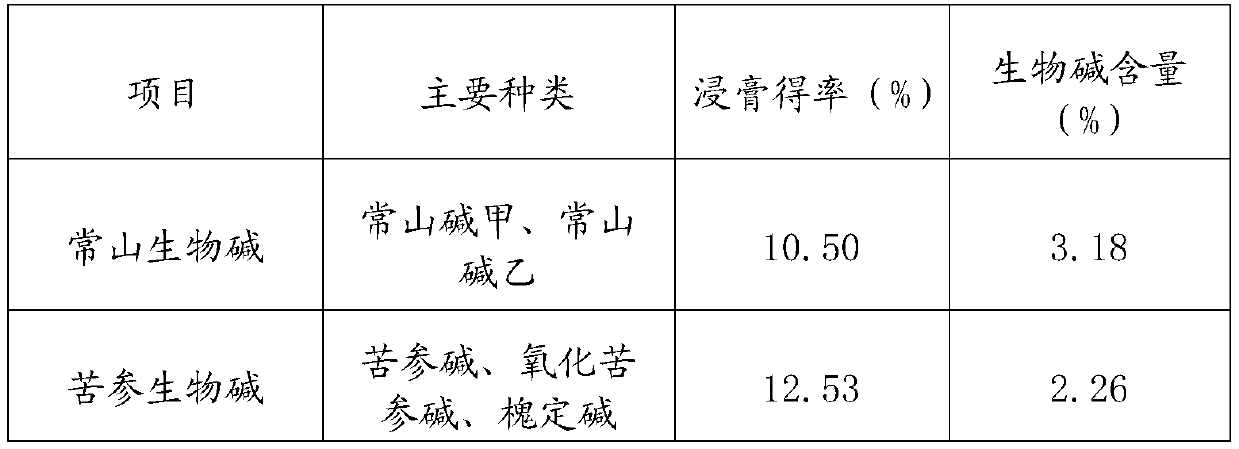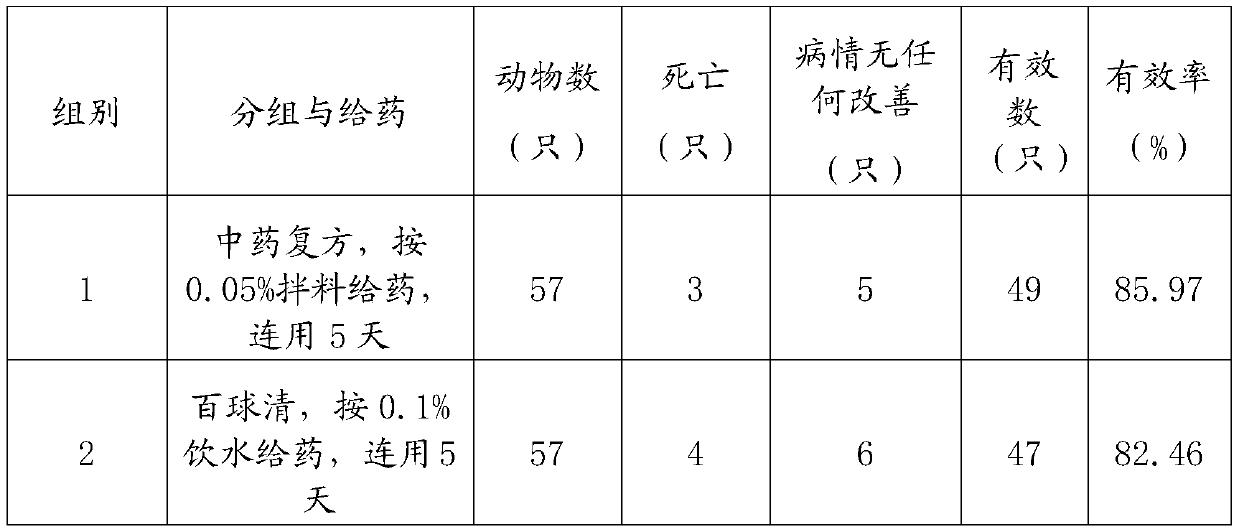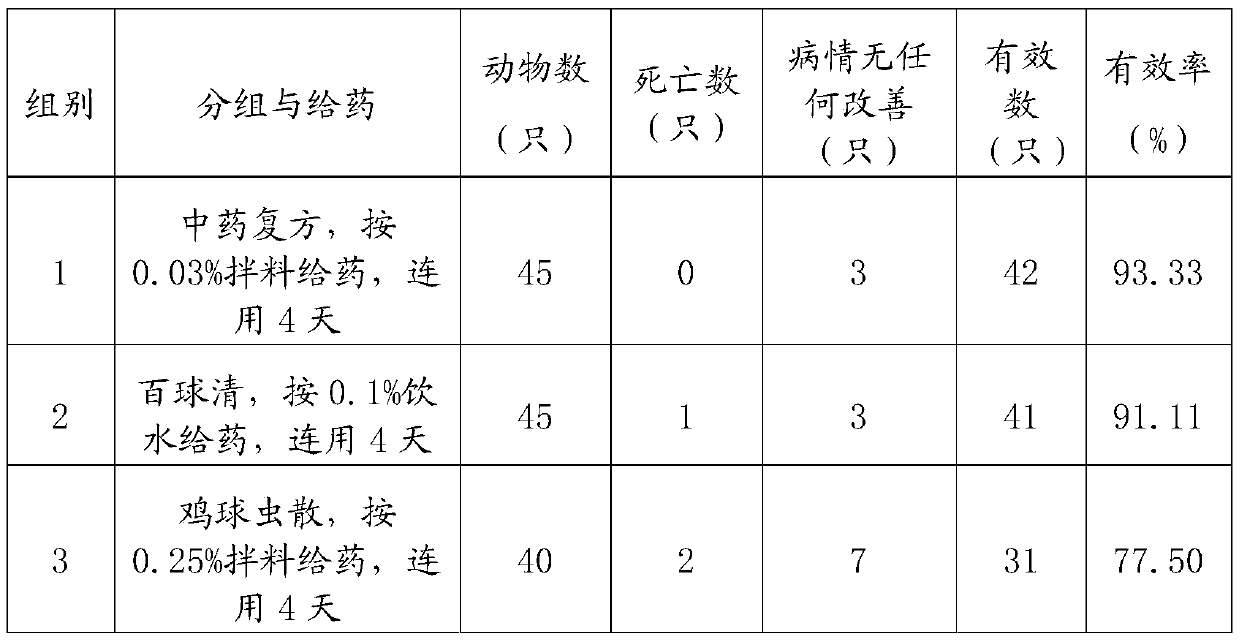Anti-coccidial Chinese medicine compound and application thereof
An anti-coccidial and traditional Chinese medicine technology, applied in anti-infective drugs, pharmaceutical formulations, drug combinations, etc., can solve problems such as no reports in research, and achieve the effects of reducing animal death, reducing bacterial secondary infection, and ensuring quality and safety.
- Summary
- Abstract
- Description
- Claims
- Application Information
AI Technical Summary
Problems solved by technology
Method used
Image
Examples
Embodiment 1
[0019] The weight addition amount of the Chinese medicine compound in the feed is 0.05% (0.5kg / ton of feed).
[0020] Case 1: In August 2017, a Rex rabbit farm in Bayannaoer City, Inner Mongolia, 4 weeks old, had a total of 500 rabbits, of which 126 became ill (12 died). The sick rabbits were depressed, severe diarrhea, neurological symptoms appeared in the later stage, the head was thrown back, the limbs twitched, screamed, and finally died. Anatomy found that the dead rabbits had flatulence, hepatomegaly, and blood vessels and mucous membranes in the intestinal walls of the duodenum, jejunum, and ileum were congested. Microscopic examination of feces found a large number of coccidiosis oocysts, and the diagnosis was rabbit coccidiosis. After communicating with the animal owners, all the remaining diseased rabbits (114) were used for the test, and were randomly divided into the Chinese medicine compound group and the dichlorothiazide group. The results showed that after 3-4...
Embodiment 2
[0024] The weight addition amount of the Chinese medicine compound in the feed is 0.03% (0.3kg / ton of feed).
[0025] Case 2: In September 2018, a meat duck farm in Tianshui City, Gansu Province, 15 days old, had a total of 600 ducks, of which 132 became ill. The sick duck had depression, loss of appetite, and bloody diarrhea; the autopsy found that the dead duck had swollen duodenum, enlarged mesenteric lymph nodes, and a large number of bleeding points; a large number of coccidiosis oocysts were found in the stool microscope, and it was diagnosed as duck coccidiosis. After communicating with the livestock owners, all the sick ducks were used for the experiment, and were randomly divided into the Chinese medicine compound group, the Baiqiuqing group and the chicken coccidia powder group, and the rest of the healthy ducks were drinking Baiqiuqing for 2 days for prevention. The results showed that after 2-3 days of administration, the clinical symptoms of the test ducks in each...
Embodiment 3
[0029] The weight addition amount of the Chinese medicine compound in the feed is 0.02% (0.2kg / ton of feed).
[0030] Case 3: In July 2018, a laying hen farm in Yongdeng County, Gansu Province, 35 days old, had a total of 2,000 chickens in stock, and 350 of them became ill. The sick chicken was depressed, the feathers were disheveled, the desire to eat decreased, and a large amount of bloody stool was discharged; the cecum and duodenum of the dead chicken were found to be severely swollen, and there were bloody contents; a large number of coccidia oocysts were found in the stool microscope, and the diagnosis was chicken coccidia sick. After the consent of the animal owner, all the sick chickens were used for the experiment, and were randomly divided into the Chinese medicine compound group, the dichlorothiazide group and the chicken coccidia powder group, and the remaining healthy chickens were given dichlorothiazide for 2 days of continuous drinking water for prevention. The...
PUM
 Login to View More
Login to View More Abstract
Description
Claims
Application Information
 Login to View More
Login to View More - R&D
- Intellectual Property
- Life Sciences
- Materials
- Tech Scout
- Unparalleled Data Quality
- Higher Quality Content
- 60% Fewer Hallucinations
Browse by: Latest US Patents, China's latest patents, Technical Efficacy Thesaurus, Application Domain, Technology Topic, Popular Technical Reports.
© 2025 PatSnap. All rights reserved.Legal|Privacy policy|Modern Slavery Act Transparency Statement|Sitemap|About US| Contact US: help@patsnap.com



